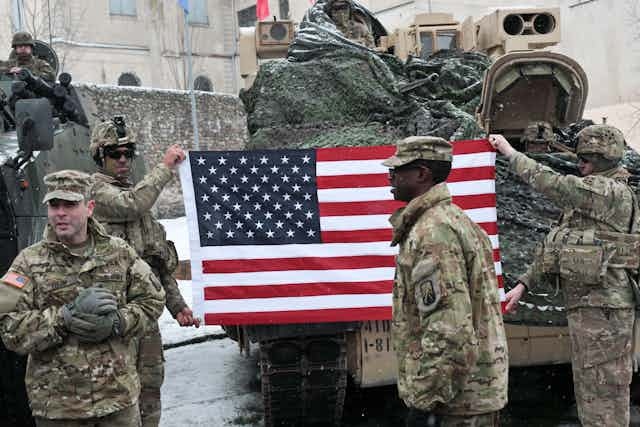While America celebrates the inauguration of its 45th president, there is widespread concern about his potential approach towards NATO, his relations with Russia – and whether Russian president Vladimir Putin will try to take advantage of any signs of weakness or disunity within the western treaty alliance. There are, potentially, troubling times ahead which have foreign policy analysts worried.
Before the outcome of the US presidential election were known, many commentators were talking about a “new Cold War”, against a backdrop of Russian involvement (alleged or otherwise) in Crimea and eastern Ukraine. Having repeatedly campaigned on a platform of “America first” – an approach which might mean less commitment to overseas military undertakings in general (and NATO in particular) – recent pronouncements from the president-elect have done little to calm nerves in eastern Europe.
So what does NATO itself think? Secretary-general Jens Stoltenberg has expressed guarded concern about the future of US involvement – although diplomatic niceties required that he chose his words carefully – saying he was “absolutely confident that President Trump will maintain American leadership” of NATO. The recent deployment of an American armoured brigade is reassuring for eastern Europe – and other NATO members (notably the UK with the ongoing deployment of Typhoon jets) have made clear their commitment to the Baltic states.
But the US deployment could be reversed by the new commander-in-chief in Washington – and while there has been vocal, if somewhat muted, support for NATO from European capitals there has been no definitive commitment to Article V which states that an attack on one NATO member is an attack on all – the bedrock of the NATO Treaty. There have also been no new commitments by NATO members other than the US, Greece and the UK to bring their defence spending towards the NATO target of 2% of a country’s GDP.
There are sound reasons for this: both the state of the broad European economy and not wishing further to antagonise the Kremlin are in themselves good reasons to tread warily. There is, furthermore, a degree of “wait and see” on the part of European leaders. Will Trump carry through with his rhetoric, or will realpolitik and the centralising tendencies of office, with its bureaucracy (all those committees, existing agreements, the political trade-off between the White House and the Hill), result in a change of direction?
Putin powerplay
Trump’s recent pronouncements on NATO seem, if anything, to be becoming more strident and are running in parallel with growing concerns about the direction his relationship with Putin will take. Analysing recent events from a Russian viewpoint, there is certainly little obvious in the way of Western words, let alone actions, to deter further acts, or threats, of Russian aggression. Putin appears to enjoy unprecedented levels of support and approval at home and his twin-track agenda of playing the strong man and rebuilding Russia’s world standing are playing to traditional Russian fears.

The Russian leader is, of course, limited to an extent by the pressures of trade, globalisation and (perhaps to a lesser degree) world opinion. Russia is also subject to the economic sanctions imposed by Europe and the US, which Trump has indicated he will, at least initially, continue. Low oil prices will also affect his capacity for aggressive foreign policy gambits.
But the Kremlin has undertaken some clever diplomacy to restore links with Turkey, a key NATO member, and build its influence there. There is perhaps an example here of how Russia will continue to act – Putin seems determined to move Turkey from a Western sphere to a Russian one. And against the backdrop of civil unrest, a struggling economy, stalled EU accession, a potentially declining NATO and a style of increasingly autocratic governance from President Recep Tayyip Erdoğan that is more attuned to the Kremlin than Brussels, the Russian leader might be said to be succeeding.
The idea of possible Turkish secession from NATO is not a reassuring picture for the Baltic states. After the heady days of Soviet withdrawal in the region in the 1990s and the subsequent accession to NATO and EU membership, the countries of this region could be forgiven for a degree of unease. But whether Russia really would risk all via an invasion of one or another of the Baltics is less clear – where’s the gain? Putin is, if nothing else, a realist and any potential domestic kudos garnered from a military attack on a Baltic state would have to be balanced against the international reaction it would generate – and it seems unlikely that Putin would risk the backlash.
Over to you Mr President
What of the future of NATO itself? That is far harder to judge. For years, NATO has been seeking a purpose beyond a seemingly hollow collective security requirement. It must be said, however, that with growing Russian military spending, capability and willingness to resort to hard power this may be starting to appear to be less hollow. And after the high-water mark of the return of the Balkan states, NATO has struggled to define its role.
A resurgent Russia might just re-energise the capitals of western Europe in terms of defence priorities. And Trump? In many ways, he is going to set the agenda: will he indeed risk US standing, influence and defence sales with a significant retrenchment policy? He is, after all, a businessman and – from the viewpoint of the American bottom line – a retreat into political isolationism would more likely harm the American economy than grow it.
All eyes are on Washington. If nothing else, we should by now have started to be accustomed to off-the-cuff, but potentially significant, pronouncements from Trump. Keep your Twitter feed open.

